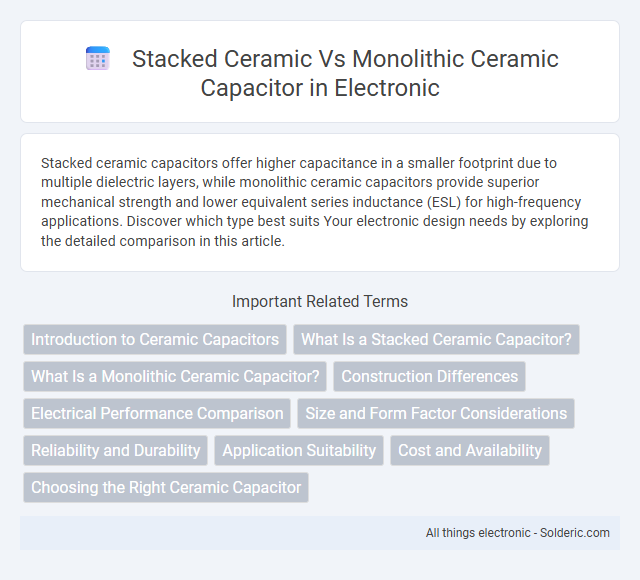Stacked ceramic capacitors offer higher capacitance in a smaller footprint due to multiple dielectric layers, while monolithic ceramic capacitors provide superior mechanical strength and lower equivalent series inductance (ESL) for high-frequency applications. Discover which type best suits Your electronic design needs by exploring the detailed comparison in this article.
Comparison Table
| Feature | Stacked Ceramic Capacitor | Monolithic Ceramic Capacitor |
|---|---|---|
| Construction | Multiple ceramic layers stacked and sintered | Single solid ceramic block |
| Capacitance Range | Wide, up to several microfarads (uF) | Generally lower, up to nanofarads (nF) to low microfarads |
| Size | Compact for given capacitance | Usually larger for equivalent capacitance |
| Application | High-frequency filtering, decoupling in compact circuits | General purpose, high voltage applications |
| Reliability | High, good mechanical stability | Good, but prone to cracking under stress |
| Cost | Generally higher due to complex manufacturing | Lower, simpler manufacturing process |
| ESR/ESL | Low Equivalent Series Resistance (ESR) and Equivalent Series Inductance (ESL) | Higher ESR and ESL |
Introduction to Ceramic Capacitors
Stacked ceramic capacitors consist of multiple thin ceramic layers stacked to achieve higher capacitance within a compact size, while monolithic ceramic capacitors are typically made from a single ceramic block with electrodes embedded inside. These capacitors are essential in electronic circuits for filtering, bypassing, and decoupling due to their high reliability, low equivalent series resistance (ESR), and excellent frequency response. Dielectric materials such as Class 1 (NP0) and Class 2 (X7R) influence the stability and capacitance range, affecting the choice between stacked and monolithic designs in applications.
What Is a Stacked Ceramic Capacitor?
A stacked ceramic capacitor consists of multiple ceramic dielectric layers stacked together with internal electrodes, creating a compact structure that allows higher capacitance within a small footprint compared to monolithic ceramic capacitors. Monolithic ceramic capacitors, by contrast, are made from a single ceramic block with electrodes embedded internally. Your choice depends on the required capacitance, size constraints, and application, as stacked capacitors typically offer improved capacitance density and better performance in high-frequency circuits.
What Is a Monolithic Ceramic Capacitor?
A monolithic ceramic capacitor is a single-layer or multilayer electronic component built by stacking thin ceramic dielectric layers alternated with metal electrodes to create a compact, high-capacitance device. Unlike stacked ceramic capacitors, which physically stack multiple discrete capacitors, monolithic ceramic capacitors integrate all layers into one solid piece, enhancing reliability and reducing equivalent series inductance (ESL). Your choice of monolithic ceramic capacitors ensures efficient performance in filtering, decoupling, and timing circuits due to their stable capacitance and low losses.
Construction Differences
Stacked ceramic capacitors consist of multiple thin ceramic layers stacked together with internal electrodes, enhancing capacitance and enabling compact sizes in electronic circuits. Monolithic ceramic capacitors are built as a single solid ceramic block with electrodes embedded between layers, offering simpler construction but typically lower capacitance density compared to stacked types. Understanding these construction differences helps you select the capacitor that best meets your device's size and performance requirements.
Electrical Performance Comparison
Stacked ceramic capacitors offer higher capacitance values and better voltage ratings in a smaller package compared to monolithic ceramic capacitors, which typically provide lower equivalent series resistance (ESR) and improved high-frequency performance. The multilayer structure in stacked ceramics reduces parasitic inductance, enhancing ripple current handling and stability under varying temperatures. For your applications requiring compact size with high energy density and reliable electric performance, stacked ceramic capacitors deliver superior overall effectiveness than monolithic types.
Size and Form Factor Considerations
Stacked ceramic capacitors offer a smaller size and higher capacitance per volume due to their multilayer construction, making them ideal for compact electronic devices. Monolithic ceramic capacitors, while generally larger for equivalent capacitance, provide simpler manufacturing and potentially better mechanical robustness. Design engineers select stacked ceramic capacitors when space constraints are critical, prioritizing minimized footprints without sacrificing capacitance.
Reliability and Durability
Stacked ceramic capacitors exhibit enhanced reliability due to their multi-layer construction, which evenly distributes mechanical stress and reduces the risk of cracking under thermal cycling. Monolithic ceramic capacitors, while simpler in design, are more susceptible to microcracks and dielectric degradation over time, affecting long-term durability. The laminated layers in stacked ceramics provide superior resistance to voltage surges and mechanical vibrations, making them ideal for high-reliability applications.
Application Suitability
Stacked ceramic capacitors offer higher capacitance values in a compact form, making them ideal for high-density applications like smartphones, tablets, and compact electronic devices where space-saving is critical. Monolithic ceramic capacitors provide excellent stability and low equivalent series resistance (ESR), which suits them for high-frequency circuits, precision filtering, and power supply decoupling in automotive and industrial electronics. Selection between stacked and monolithic ceramic capacitors depends on the specific requirements for capacitance, size, and electrical performance within the targeted application environment.
Cost and Availability
Stacked ceramic capacitors generally offer lower cost and higher availability due to mass production and widespread use in consumer electronics. Monolithic ceramic capacitors tend to be more expensive because of their complex manufacturing process and are less readily available for niche high-performance applications. Your choice depends on budget constraints and the specific supply chain demands of your project.
Choosing the Right Ceramic Capacitor
Choosing the right ceramic capacitor depends on your application's performance requirements and space constraints. Stacked ceramic capacitors offer higher capacitance in a smaller footprint due to their multilayer design, making them ideal for compact, high-frequency circuits. Monolithic ceramic capacitors provide superior stability and reliability, suitable for applications requiring consistent performance under varying temperatures and voltages.
stacked ceramic vs monolithic ceramic capacitor Infographic

 solderic.com
solderic.com